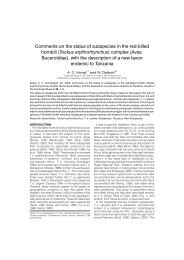EAZA Hornbill Management and Husbandry Guidelines
EAZA Hornbill Management and Husbandry Guidelines
EAZA Hornbill Management and Husbandry Guidelines
You also want an ePaper? Increase the reach of your titles
YUMPU automatically turns print PDFs into web optimized ePapers that Google loves.
5) Diet requirements<br />
5.1 Formulation of captive diets<br />
5.1.1 Fruits<br />
5.1.2 Palatability <strong>and</strong> Familiarity<br />
5.1.3 Colors<br />
5.1.4 Fiber<br />
5.1.5 Protein<br />
5.1.6 Calcium<br />
5.1.7 Iron<br />
5.1.8 Enrichment of the st<strong>and</strong>ard diet<br />
5.2 Diet changes during the breeding season<br />
5.3 Diet suggestions<br />
5.3.1 Food items<br />
5.3.2 Manufactured diets<br />
5.3.3 Gelatin “cake”<br />
6) Reproduction<br />
6.1 Nesting cycle preparations<br />
6.2 Breeding behavior<br />
6.3 Nest<br />
6.3.1 Type of nest <strong>and</strong> nest materials<br />
6.3.2 Inside measurements<br />
6.3.3 Dimensions of the nest entrance<br />
6.3.4 Plastering the nest opening<br />
6.3.5 Nest lining<br />
6.3.6 Nest humidity <strong>and</strong> temperature levels<br />
6.3.7 Inspection door <strong>and</strong> observation devices<br />
6.3.8 Camera monitoring of nests<br />
6.4 Chick development <strong>and</strong> care<br />
6.5 Artificial incubation<br />
6.6 H<strong>and</strong>-rearing<br />
6.6.1 Abnormal imprinting<br />
7) Social behavior <strong>and</strong> pair/group composition<br />
7.1 Human-hornbill interactions<br />
7.2 Introductions <strong>and</strong> pair formation<br />
7.2.1 Pair compatibility assessment<br />
7.2.2 Pair formation methods<br />
7.2.2.1 Sunda wrinkled hornbill dating center at Heidelberg Zoo<br />
7.2.2.3 Great hornbill breeding center at Arnhem Zoo<br />
7.2.3 Introductions<br />
7.3 Conspecific groupings <strong>and</strong> aggression




